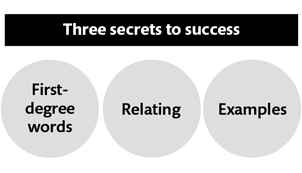Chapter 6
What language should I speak?
The middle of your presentation
Let’s look at the middle of your presentation.
We have looked at the beginning of a presentation and why an audience will listen. We have also looked at the conclusion. Now we need to look at the rest of a presentation.
A great presentation grabs the mind of the audience at the beginning, navigates them through all the various parts, themes and ideas, never letting go, and then gets them to the point of action or result.
Do you remember the diagram below?

The straight line in the diagram represents the part of the presentation where you must navigate your audience through your information, never letting them go, until you get them to the result you want.
The struggle is, you have to keep your audience engaged from the hook (the first 45 seconds) to the result.
The question is, how easy is your presentation to follow and do you have flow?
What kind of road are you?
I want you to imagine for a second that your presentation is like a car journey for your audience. They have to get from one destination to another and your presentation is the road they have to travel on.
- Are you a super slick motorway that allows the driver to effortlessly get from A to B without stress or hassle?
- Is your road signposted clearly to ensure your audience has a smooth journey with no wrong turns or unnecessary stops?
- Does your road make it easy and effortless to reach the place the audience wants to get to?

Or is your presentation journey more like this?
- Is your road so intertwined with so many other roads and options that the audience feels overwhelmed and confused before they even start?
- Do you have no clear signs to help the audience distinguish which road is right for them?
- Does getting to your destination leave your audience exhausted and frustrated about how long and unnecessary the journey took?

To ensure your presentation road is easy to travel down you must avoid the four presentation pitfalls.
Where it goes wrong
Here are the four main reasons your road is too difficult to travel down.
1. Not relevant
After hooking the audience in the first 45 seconds you then have to keep them.
You must be consistent with your engagement and linking throughout the talk. If at any time the audience feels your data is not relevant they will lose interest and you will lose them.
2. Data overload
‘Hello my name is … (insert your name here) and I am a dataholic.’
Awareness is the first step. There is help out there; you can live a long and happy life without drowning your poor unfortunate audience in data. Sometimes it’s what you don’t say that matters.
3. PowerPoint
‘Hello my name is … (ok so you know how the rest goes).’
I am deadly serious though, what are you all doing with PowerPoint?
PowerPoint is a very powerful visual aid when used correctly. Below is a list of what PowerPoint is NOT for.
I am going to talk to you in detail about presentation software later in the book.
Don’t use PowerPoint for:
- your notes;
- your crutch;
- a substitute for preparation;
- the handout (given before, during or after the talk);
- the PowerPoint that gets circulated to the people that weren’t at the talk.
4. They don’t understand
You need to speak in English and not in business-speak for your message to be understood.
I know you don’t want to be seen to ‘dumb things down’ or speak in what you perceive to be baby talk. Dumbing down and baby talk are very different to being clear, concise and understandable. I am not asking you to dumb anything down; I am asking you to speak in a universally understood language rather than your industry dialect. In everyday conversation we speak in first-degree words. These are words that have only one meaning that everyone can understand. For example ‘road’ is a first-degree word. ‘Infrastructure’ is not.
To be understandable you have to stop:
- using concepts, acronyms and jargon without explanation;
- assuming levels of understanding that are simply not there;
- bombarding the audience with too many numbers with no context for those numbers;
- using ten sentences to say what could be said in two;
- talking about what you are going to talk about instead of just talking about it. You need to get to the point.
Facts are, of course, critical but the reality is they take time to penetrate the brain.
A mistake many professionals make is assuming their colleagues, customers or clients understand the everyday jargon they use. In most instances, this is not the case and can result in serious miscommunication and misunderstanding.
Your audience (internal and external) does not understand your industry language as much as you think or maybe in the way you think. They may have heard the acronym or come across the theory but that does not mean they understand it in the way you do.
Please don’t be over-confident in your assumptions. There is a very good chance you’re mistaken in assuming understanding that simply isn’t there.
‘If you can’t explain it simply, you don’t understand it well enough.’
Albert Einstein, Physicist
Creating understanding
The purpose of a presentation is to create understanding.
If you don’t make your facts understandable you are essentially expecting your audience to:
- take on board a catalogue of data;
- assimilate the data immediately with no real context;
- reach the same conclusion you have reached.
(And all of this in 20 minutes.)
The onus is never on the audience, it is on the speaker to keep the listener engaged and keep things clear.
You must know your audience and how they will interpret what you are saying. Something that is incredibly natural and everyday to you may not be to them. You must speak to your audience in a language they can understand.
You have to step back from your own assumptions. If in doubt start at the beginning and make sure everyone understands.
To ensure engagement throughout and to make sure you are creating understanding you must avoid the four presentation pitfalls (above) and always do the following:
- Use first-degree words (everyday language) to explain your messages and concepts before you start using technical terms or industry jargon.
- Relate your information to how it affects your audience.
- Use real-life examples, stories or analogies to explain your concepts and bring your facts to life.

In case you don’t know, first-degree words are words with only one meaning.
The power of a picture
A concept is an abstract general idea that could have many meanings. ‘Sustainability’ is a concept. I don’t think anyone actually knows what that word means. Children and adults think in pictures and concrete thoughts rather than general ideas.
We go through years of education and all we are taught is how to memorise data and concepts. Only a very small percentage of teachers take those concepts and make them stick, make us understand and remember them.
Great presenting is about the creation of understanding. Presenting concepts to an audience and assuming they will be able to take the general abstract ideas and understand them as you do is senseless and ultimately ineffective.
You, the presenter, must take the concepts and make them real. You must present them so the audience can touch them, taste them and feel them.
People relate easily (and emotionally) to stories, examples, analogies and case studies. More importantly, people remember them. Our brains are hardwired for story. Story was how cultures were passed from generation to generation. Stories are interesting, easy to listen to and you remember the message. If you have an important message, concept or idea that must be remembered by your audience concentrate on telling a story or finding one concrete example to support your point. Facts are important and can even be critical but they penetrate the brain very slowly – remember learning your times tables or your French verbs.
Stories make facts speak. They give them an emotional context. They make facts digestible and appetising. As well as the facts entering the brain more quickly, in the process you become more human, more approachable and more audience-friendly. The best speakers reach into their bag of stories and examples and this is what brings their presentations to life. This is what connects them to the audience.
